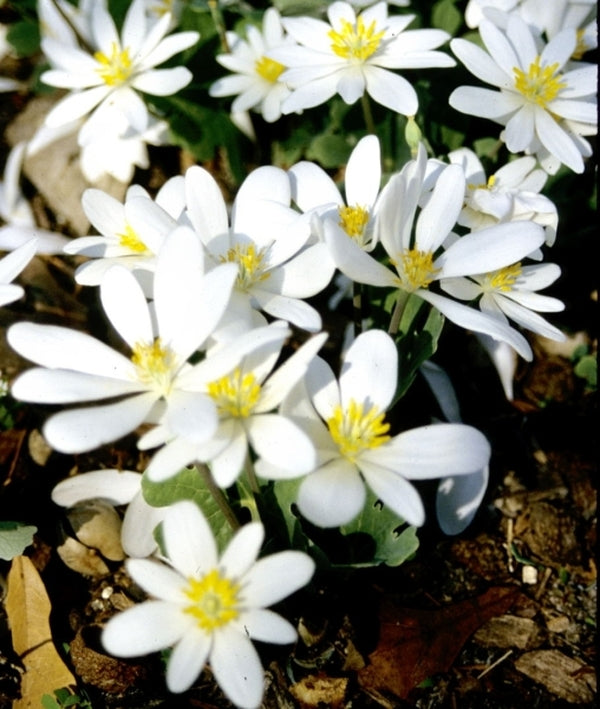Sanguinaria canadensis
Bloodroot
Item #: 2392
Zones: 4a to 8b
Dormancy: Winter, Summer, Fall
Height: 6" tall
Origin: United States
Pot Size: 3.5" pot (24 fl. oz/0.7 L)
Sanguinaria canadensis is a native member of the poppy family that can be found in woodlands from North Dakota south to Florida. The easy-to-grow bloodroot is certainly one of the stars of early spring woodland gardens. Each clump can produce dozens of 6" flower stalks that are topped with 1" white daisies in early April (NC). The flowers are followed by rounded green leaves with lobes on one side, resembling the smile of the protagonist characters from the movie Deliverance. Bloodroots are best sited in a slightly moist woodland setting and should be divided every three years to prevent clump decline...our offerings are flowering-sized plants.
Maintenance:
Bloodroot requires almost no maintenance. It seems to quietly disappear unnoticed when it goes dormant in late summer. It does benefit from division of clumps when they get crowded after many years. They also tolerate being divided. This can be done most anytime, though it would be best, if possible, to avoid the time when the leaves are developing. Once fully matured, the leaves will not be affected by division. The subterranean rhizomes are finger thick and bright red inside. Divide into separate plants and replant about 6" apart. Long rhizomes can be cut into shorter sections each several inches long. As rhizomes are underground stems, cutting them into shorter pieces produces the same results as pinching back an above ground stem:The dormant lateral buds will now grow with the removal of the terminal bud. Do not expect new growth from these rhizome cuttings until the following spring.
Growing Conditions:
Sanguinaria canadensis is a spring ephemeral, coming into growth and bloom early in the year when it can make use of the sunlight before the canopy trees leaf out. It will succeed in bright shade or part day sun areas. It can also be grown in sunny locations where it will grow more strongly. Avoid a poorly drained soil. It will tolerate a dry site but perform more satisfactorily in moist well drained soil.
Garden Value:
Bloodroot blooms very early in the year, well ahead of the spring peak, so its flowers are most welcome. The double forms are especially beautiful. Bloodroot foliage is of an interesting form, somewhat like that of a fig, Ficus carica, so it can be of value in the garden especially when contrasted with different forms and texture. The foliage is especially charming at the time of bloom as a single leaf will wrap around each flower stalk like a shawl thrown over one's shoulder.


-
Related Articles
-
Other Attributes
Genus: Sanguinaria
Flower Color: White/Cream
Leaf Color: Green
Bloom Time: Spring
Container Role: Fillers
Garden Themes: Cottage Garden Plants , Fairy Garden Plants , Gnome Gardens , Night Gardens , Rock Garden Plants , White Garden
Other: Florida Native Plants , Georgia native plants , Medicinal Plants , North American Native Plants , North Carolina Native Plants , Ornamental Seed or Fruit , Rabbit Resistant Plants , Texas Native Plants , United States Native Plants



